
How to Get to Qaraqalpaqstan

|
How to Get to Qaraqalpaqstan
|
|
ContentsPlanning your TripTravel Agents Visas International Flights Immigration and Customs Domestic Flights By Rail By Bus By Hire Car Overland from Tashkent Overland from Turkmenistan Overland from Kazakhstan Planning your TripDue to its landlocked location, the climate of Qaraqalpaqstan is extreme continental. In the summer solar radiation is high and humidity is relatively low, the average July temperature reaching 28°C in the south and 26°C in the north. However maximum summer temperatures can reach 45°C, while in the open desert they can exceed 50°C. Winters are moderately cold with little snow, the average temperature in January falling to about -5°C in the south and about -8°C in the north. See Climate.The most pleasant times to visit are from late April to early June and from the beginning of September to early October.
Early Autumn is a nice time to visit Qaraqalpaqstan.
|
| New Year's Day | 1 January |
| International Women's Day | 8 March |
| Nawrız Bayram | 21 March |
| Labour Day | 1 May |
| Victory or Memorial Day | 9 May |
| Independence Day | 1 September |
| Teachers' Day | 1 October |
| Flag Day | 18 November |
| Constitution Day | 8 December |
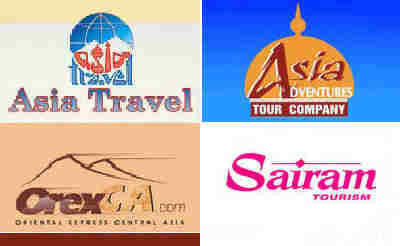
|
We have personally had good experience with the following two companies:
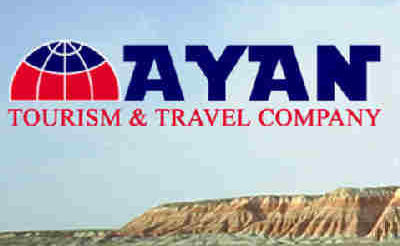
|
They can organize customized tours, accommodation in Konya Urgench, English-speaking guides, and travel by 4WD using GPS navigation for those
really wanting to get off the beaten track:
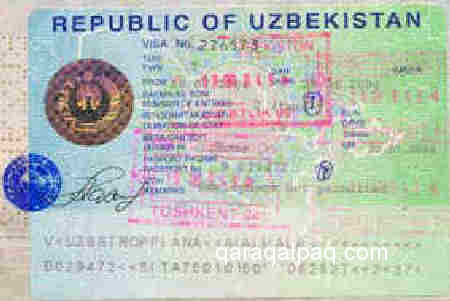
|
In the past Uzbekistan operated a 72-hour transit rule that allowed travellers with visas from other members of the Commonwealth of Independent
States to transit Uzbekistan without an Uzbek visa. This has now been suspended. Transit passengers without a visa cannot leave the transit lounge.
Citizens of Austria, Belgium, France, Germany, Italy, Japan, Latvia, Malaysia, Spain, and Switzerland can apply for a visa directly from their local
Uzbek embassy or consulate.
Visitors from other countries, such as the USA and UK, must arrange a "visa support letter", sometimes called a "letter of invitation", which must be
organized through a local Uzbek travel agent authorized by "Uzbektourism", the National Tourism Agency. The agent will contact the Immigration
Department of the Ministry of Internal Affairs in Tashkent, who will first vet the application before faxing a copy of the support letter to your
local embassy. For this simple task you can expect to be charged from $20 to $50 per person, depending on the agent. All of the above travel agents
provide this service. Click here for some additional information.
Check with your local embassy that they have received the copy of your letter of invitation before submitting your visa application.
Tourist visas for Uzbekistan are issued for periods of 2 weeks, 30 days, or 3 months and can be for either a single entry or multiple entries.
Visitors planning a side trip into Turkmenistan and back will obviously need a multiple entry visa.
Uzbek visas and associated fees are remarkably expensive. In the past visa fees have normally been charged in US dollars, so people applying outside
of the USA have had to calculate the appropriate amount in their own local currency. However in London the Uzbek consulate has recently been asking
visa applicants to pay in Sterling when they telephone for advice. The fee for a 30 day visa has been £47.
The Republic of Uzbekistan has missions in the following countries: Afghanistan, Austria, Azerbaijan, Belgium (Luxemburg), Canada, China, Egypt,
France, Germany, India, Indonesia, Iran, Israel, Italy, Japan, Kazakhstan, Korea, Kyrgyzstan, Latvia, Malaysia, Pakistan, Poland, Russian Federation,
Saudi Arabia, Tajikistan, Turkey, Turkmenistan, Ukraine, USA, and Vietnam. It has consular departments in the following cities: Athens (Greece),
Bangkok (Thailand), Dubai (UAE), Frankfurt (Germany), Istanbul (Turkey), Jeddah (Saudi Arabia), Mazar i-Sharif (Afghanistan), and New York (USA).
International Flights
Most tourists arrive in Qaraqalpaqstan having entered Uzbekistan via Tashkent (airport code TAS). As the enthusiasm for visiting Central Asia has
waned in recent years, so international carriers such as Lufthansa, British Airways, and Air France have pulled their routes to Uzbekistan, leaving
Uzbekistan Airways (airline code HY) with a virtual monopoly. The current lack of competition for Tashkent routes means that Uzbekistan Airways
ticket prices tend to be high.
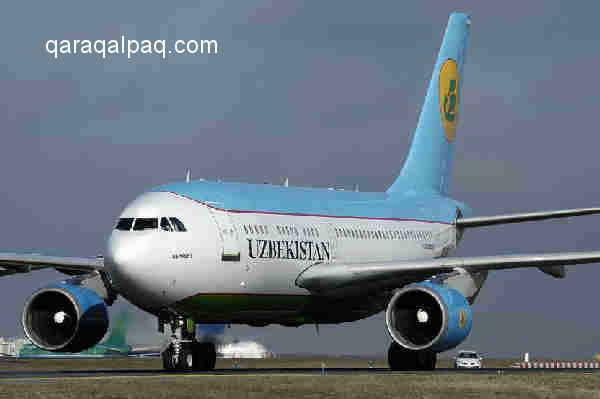
|
Formed in 1992 following Uzbekistan's declaration of independance, Uzbekistan Airways (Uzbekiston Havo Yullari) inherited the former assets of
the Uzbek operations of Aeroflot. It is regarded as one of the better managed post-Soviet airlines with a strong committment to modernize. It has a
reasonable safety record and its technical staff are trained by Lufthansa. The US Federal Aviation Authority does not assess individual airlines but
does consider an individual country's ability to support its aviation services. The FAA foreign assessment programme has given
Uzbekistan a Category 1 rating (the same as Canada, Japan,
Germany, France, Italy, and the UK) for complying with international standards and recommended practices for aircraft operation and maintenance. However
Uzbekistan Airways does not have a 100% safety record - it has had
seven accidents in the last twenty years, all involving aircraft of Soviet manufacture.
With regard to customer service, the UK-based airline quality assessment company
Skytrax only gives Uzbekistan Airways a two star rating. The airline scores poorly on economy check-in, flight amenities and entertainment, and
cabin staff response to pasenger requests. As frequent Uzbekistan Airways customers ourselves, we fully endorse their assessment.
Uzbekistan Airways fly to Tashkent from New York (via Riga), London, Frankfurt, Paris, Milan, Rome, Moscow, Istanbul, Cairo, Delhi, Seoul,
Tokyo, Bangkok, and Kuala Lumpur.
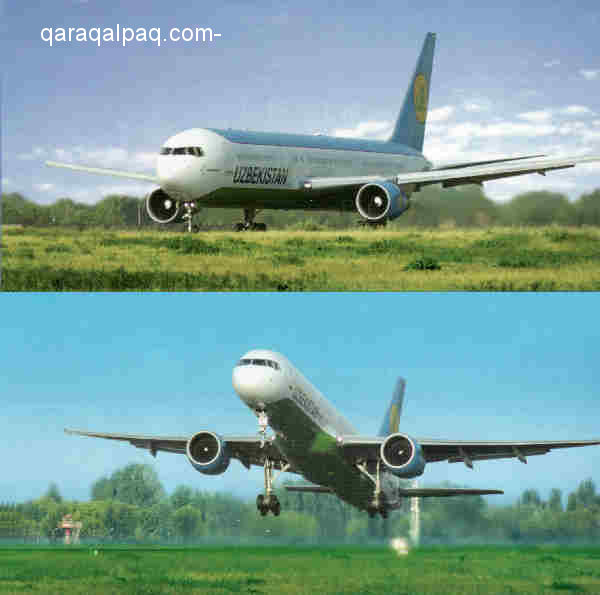
|
Schedules change frequently and travellers should get up to the minute information. Some services only run during the high season. Unfortunately
the Uzbekistan Airways website: http://www.uzairways.com is slow and frequently out of operation
– welcome to Uzbekistan!
Uzbekistan Airways is a far from easy airline to deal with directly and we recommend that you book your flights through your local travel agent if
at all possible. In No'kis the Uzbekistan Airways office is at 43 Pushkin ko'shesi, telephone 222 78 63.
In the UK the Uzbekistan Airways flights to Tashkent are frequently heavily booked by Asian travellers heading on by a connecting flight to the Punjab
city of Amritsar. Market pricing dictates that they pay considerably less than customers who are only flying to Tashkent.
Among the limited alternatives now available are Aeroflot, who have four flights a week from Sheremetyevo, 29km north-west of Moscow; Turkish Airlines,
who fly from Istanbul; and Turkmenistan Airways (even worse than Uzbekistan Airways), from Ashgabat.
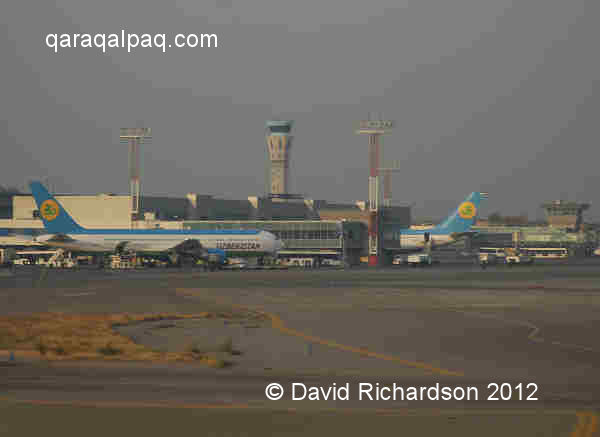
|
Tashkent Airport has been significantly upgraded in recent years. Once you get through the crowd of relatives waving farewell to their loved ones at
the entrance the check-in area is large, airy, and airconditioned and the walk to the departure gates is straightforward. However the two waiting
areas can be very busy. The arrivals area is much more cramped however, and there are only two small luggage carousels. Consequently arrivals can
be chaotic, especially since many overnight flights from Europe are scheduled to arrive at around the same time. The processing of arriving travellers
is slow, bureaucratic, and disorganized, so queues can be long. Furthermore, many locals arrive with bulky purchases, all of which must be x-rayed,
making the process of arrival even more frustrating.
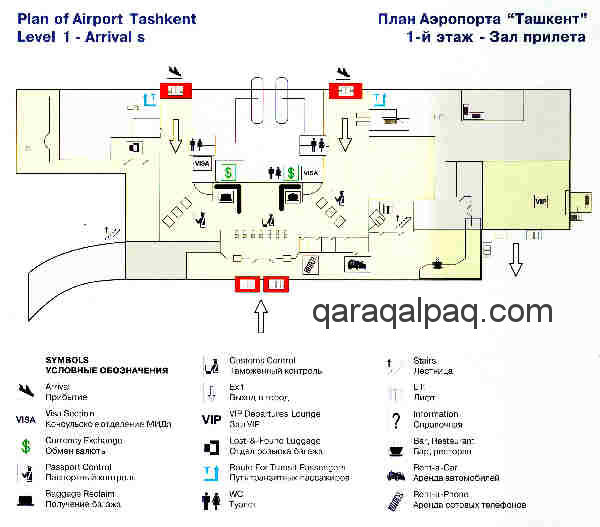
|
A more direct way to reach No'kis from Europe, avoiding the hassle of Tashkent customs, is to travel via Moscow. At the moment Uzbekistan Airways
have a one day-a-week service between Moscow and No'kis, currently flying on a Monday from Domodedovo, 35km south of Moscow using Tupolev T154 tri-jets.
The schedule in early 2008 was as follows:
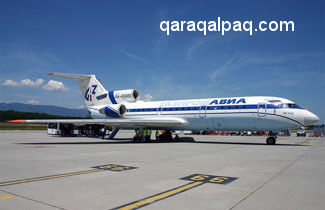
|
In May 2006 the Russian airline S7, Sibir Airlines, launched flights between Moscow Domodedovo and Urgench in the neighbouring viloyat of
Khorezm. Flight S7-965, and the return flight S7-966, currently operate each Tuesday using Tupolev T154 tri-jets. The flight leaves Moscow at 1055,
arriving in Urgench at 1620; returning from Urgench at 1740, arriving in Moscow at 1925. The one way fare starts from $190. Flights are less
frequent during the winter.
Immigration and Customs
Uzbek customs checks are strict – all non-diplomatic baggage is x-rayed on both entry and departure, which can cause delays if your flight arrives
just after another one. Before going through customs each individual must complete a customs form in duplicate, declaring a list of all valuable
temporary imports, such as photographic and video equipment, binoculars, laptop computers, mobile phones, and jewellery, along with the quantity of
individual currencies imported. One copy is kept by customs and the other retained by you. Often there are no English versions of these forms
available, only Russian and Uzbek. However it can be downloaded at http://www.visit-uzbekistan.com/uzbekistan/flights/declaration.pdf
On departure each individual must complete a second pair of forms, declaring the list of the valuable temporary imports you are departing with and
the quantity of individual currencies remaining. The same system applies each time when you make multiple entries. Problems arise if the list of
items you are departing with includes items that were not on the list you submitted on entering the country.
Uzbek customs authorities are very sensitive to the export of antiques, coins, jewellery, Oriental carpets, old textiles, and other ethnic artefacts
without a license issued by the Uzbek Ministry of Culture. The definition of antique means anything that looks old. Export licences are not easy to
obtain and even if granted require much time and patience to obtain. If you are forbidden to export an item you have purchased, you can either leave
it with your Uzbek guide or see it confiscated.
Importation of currency exceeding $10,000 (US) is subject to a one percent duty. In theory foreigners can face fines upon departure if they are
unable to produce certificates verifying the legal conversion of their foreign currency. They may also be asked for receipts to account for their
local expenditure. In practice foreign tourists are generally left alone unless something shows up during the x-ray of their baggage. Be warned,
Tashkent airport uses sensitive modern x-ray equipment, which can even identify the patterns on carpets hidden inside your baggage.
Domestic Flights
There is at least one daily flight between Tashkent and No'kis (airport code NCU), normally HY1001/1002, which departs at around 0700. This is
usually an Antonov twin-propeller AN-24, which is rather noisy and slow, taking 2¾ hours for the journey. There are normally two flights a
day to nearby Urgench, the closest airport to Khiva. However schedules can change without warning and occasionally the two flights are combined
into one. At other busy times they sometimes put on a second, later return flight to No'kis - HY1007/1008.
The flight path goes south of Aydarku'l Lake and the approach to No'kis offers good views of the Amu Darya and the Qizil Qum, which comes right up to
the edge of the city. The cabin crew often announce that photography from the plane is forbidden, for reasons that are beyond our comprehension.
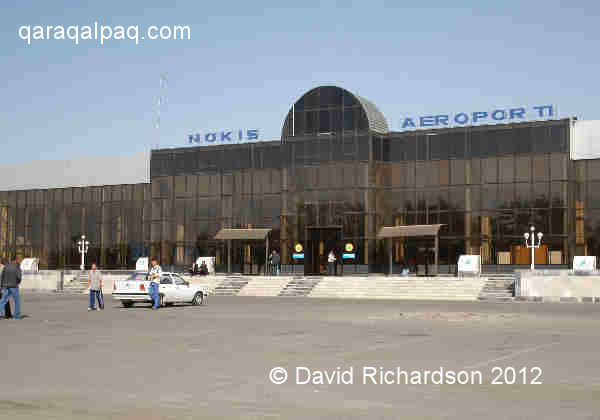
|
No'kis Airport is small and modern and a pleasure to travel into and out of. The airport is on the edge of the city only 2km from the centre.
Unlike other airports in Uzbekistan, security seems more relaxed and it is possible for vehicles to stop directly outside the terminal. Taxis
are normally available outside the terminal building. If not, the main road - Doznazarov - is just a 50 metre walk away and there you can hail
a passing bus or jo'nelisli into the centre.
By Rail
A cheaper and more interesting way to reach Qaraqalpaqstan is by rail. The main advantage of entering Qaraqalpaqstan by train, especially from
Kazakhstan, is that you traverse a completely different part of the country that people rarely get to see. Travelling from Tashkent by train rather
than road means that you avoid over a dozen road checkpoints.
In the past travel by rail was not recommended in Uzbekistan, other than for rail enthusiasts. The older tracks are uneven so many trains are slow,
and seats can sometimes be hard and uncomfortable. However things are changing fast. In 2007 a new air-conditioned train service came into
operation between Bukhara and Tashkent, replacing the earlier overnight service. The train from Bukhara leaves Kagan station daily at 0805, while
the return train from Tashkent leaves daily at 0815. The journey takes just 6½ hours. Local people were so impressed that they were no longer
using the bus but were taking a packed lunch and enjoying the train. Unfortunately a comparable service does not yet operate between Tashkent and
No'kis, but it is likely that the quality and speed of trains will be upgraded in time.
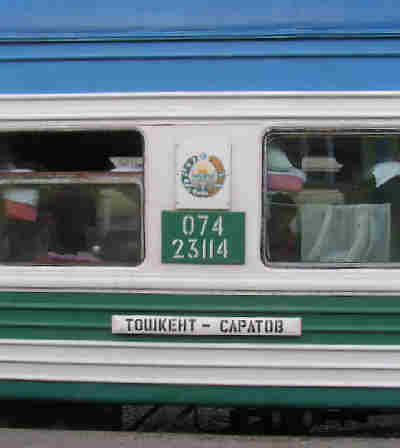
|
Visitors travelling to Qaraqalpaqstan from Russia can book their tickets up to 45 days ahead at any railway station, but must present their passport
when making a booking. Purchasing tickets from ticketing agencies is considerably more expensive.
There are three types of long-distance train operating in the CIS:
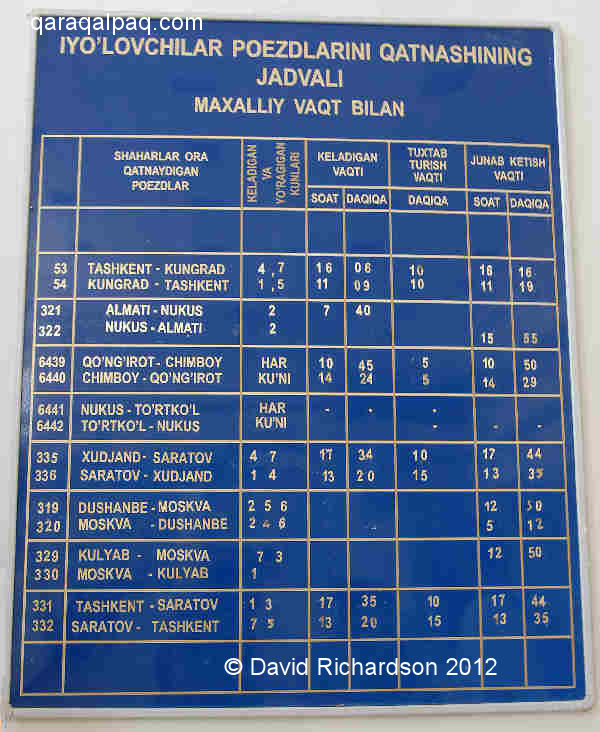
|
There is also a train service between Kazakhstan and Qaraqalpaqstan. The 917/918 runs between Qon'ırat and Beyneu, taking 12 hours and stopping at all
the small stations along the way.
Passengers should pay attention to their luggage and not leave it unattended. We have friends who have had their bags stolen from under their noses
by small gangs who create a commotion to cause confusion. Ensure that all your documentation is in order and refuse any open or veiled requests for
additional payments. It is advisable to take your own toilet paper. Locals tend to take their own food. Bed linen is normally available for a
very small extra charge from the carriage attendants, who also serve tea and snacks. In addition hot water is provided free of charge from a samovar
in each carriage. There is usually a dining car offering local dishes like plov.
We have received information that customs checks can get quite physical, especially if you are a young man travelling alone. Officials are more
respectful of people in authority, the elderly, and the infirm.
To purchase a ticket in Uzbekistan/Qaraqalpaqstan passengers also have to present their passport. Tickets are purchased in so'm.
In the autumn of 2007 prices from No'kis (in so'm) were as follows:
| Destination | 3rd Class | 2nd Class | 1st Class |
| Tashkent | 9,900 | 20,000 | 29,500 |
| Samarkand | 7,474 | 16,164 | 23,134 |
| To'rtku'l | 3,363 | 9,539 | 12,400 |
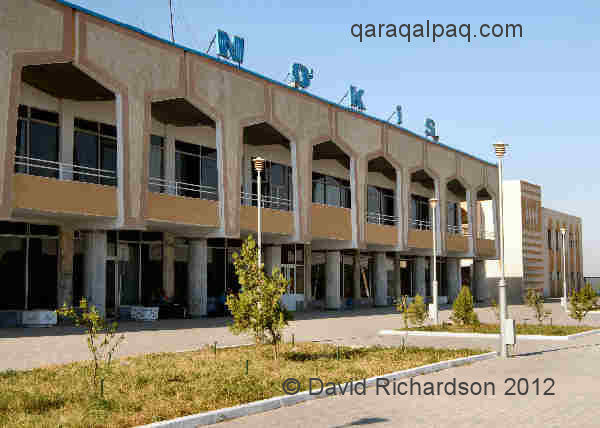
|
No'kis railway station, or vokzal, is clean, modern, and spacious and has an internal waiting area with seating. It is situated on the outskirts
of the city, at the very southern end of Dosnazarov ko'shesi, about 2km south-west from the centre. It is about 5.8km from the station to the
airport, which is also situated just off Dosnazarov. There is a bus and taxi station outside the station exit on the right, along with several small
cafés. One café is next to the station and the small Kafe Ostrov is just over the road. There are also a few small shops.
Uzbekistan Railways has an official website: http://www.uzrailpass.uz/ with pages in Uzbek,
Russian, and English containing useful information on timetables and fares.
Unfortunately the Russian railways website at http://www.rzd.ru is only in the Russian language.
A more useful site for English speakers is
http://www.russia-ukraine-travel.com/trains-in-russia.html, although it may not be so up-to-date.
Railway enthusiasts interested in travelling by rail in Uzbekistan/Qaraqalpaqstan are encouraged to visit Helmut Uttenthaler's detailed website
http://uzbekistan-railway.blogspot.com
By Bus
The cheapest way to get to Qaraqalpaqstan overland is by long-distance bus. There is even a dirt-cheap bus that comes from Moscow, crossing the
Ustyurt plateau, but this is terribly overcrowded and is not recommended except for the destitute.
Air-conditioned buses run regularly from No'kis to Tashkent, some going onwards to Almaty. It takes coaches 10 to 11 hours
to get to Bukhara, 20 hours to get to Tashkent, and 36 hours to reach Almaty. There is also a bus service crossing the Qara Qum from
Ashgabat to Dashoguz in northern Turkmenistan. Note that drivers leaving No'kis far prefer passengers who are travelling all the way to Tashkent.
If you only want to go to Bukhara, you might have problems if business is brisk.
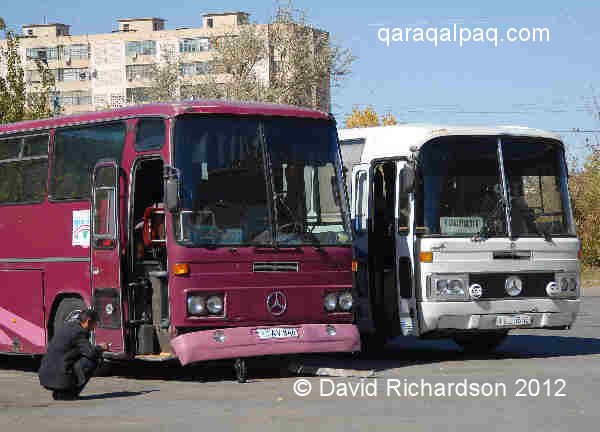
|
The buses themselves are normally old Mercedes that have been imported from private operators in Germany or Turkey. Though ten or more years old, they
are generally quite serviceable. However there have been a number of fatal accidents involving buses along the A380 highway from No'kis to Bukhara and
along the narrow cross-desert route from Ashgabat to Dashoguz. The Turkmen police have consequently outlawed overnight bus travel but some buses still
run.
There are several bus stations in No'kis, with buses going to different destinations from each location. Long-distance buses from Tashkent stop
outside the No'kis Hotel in the city centre.
By Hire Car
Unless you are on a really tight budget it is quite affordable to hire a car and driver to make the journey from Bukhara, Khiva, or Urgench to No'kis.
This gives you the freedom to stop for photos whenever you like and set your own itinerary. This can be arranged through your hotel. In Khiva you
can book a car through the Tourist Information centre opposite the Kalta Minor. Drivers also lurk around outside the main entrance to the Ichan qala
touting for business.
The most comfortable cars to hire are the locally made Daewoo Nexia or Daewoo Matiz. Occasionally you might find an old Mercedes. Avoid Ladas or
other older vehicles for long journeys. Larger minibuses are available but are not very common. It is best to book ahead.
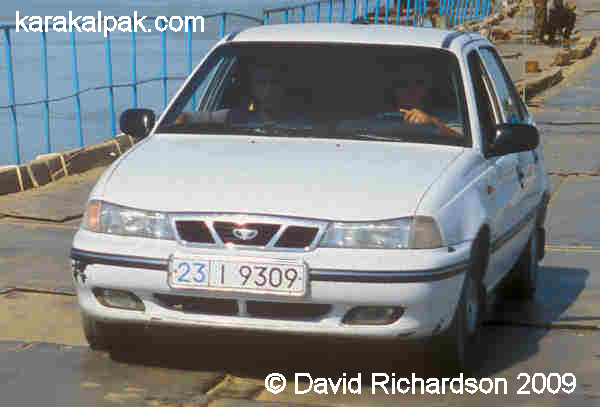
|
In the past we have been provided with a very professional service from a local company based in Urgench run by Sergey Akhmedov. In 2007 a car from
Urgench to Bukhara was $80 and a minibus was $150. We paid $150 for a car and driver from No'kis to Bukhara and $100 for a two-leg
journey from Biruniy to Khiva and then Khiva to No'kis a few days later.
Sergey Akhmedov's company can be contacted through the following numbers: home 362-222-65-388 (362 is the area code for Urgench); mobile (+998 62) 251
55 38; (+998 62) 515 53 88; and (+998 62) 221 53 88.
Overland from Tashkent
In recent years the quality of the road between Tashkent and No'kis has improved markedly. It was once necessary to break the journey for overnight
stops in Samarkand and Bukhara. However today it is possible to drive from Tashkent to Bukhara in about 7 hours depending on rest stops. Bukhara
to No'kis currently takes about 6 to 6½ hours.
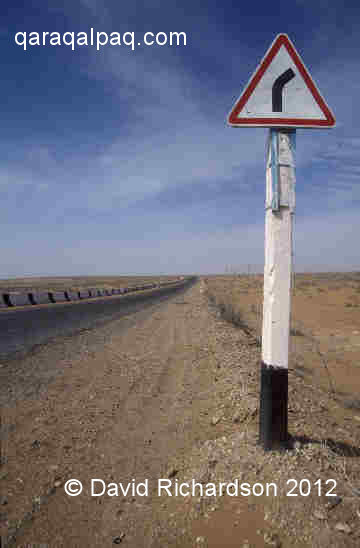
|
The condition of the road is good given the relatively low volume of traffic. The highway is wide (a minimum of 10 metres) and has a metalled surface.
The only problems arise in the vicinity of roadworks when traffic is often forced to negotiate long sections of rough unsurfaced road. The amount of
traffic is minimal, apart from in the outskirts of major centres. A recent traffic survey measured only 1,900 vehicles a day on the Khorezm section
of the A380 and a minimal 364 vehicles a day on the corresponding Qaraqalpaqstan section. Police radar speedchecks are common in built-up areas.
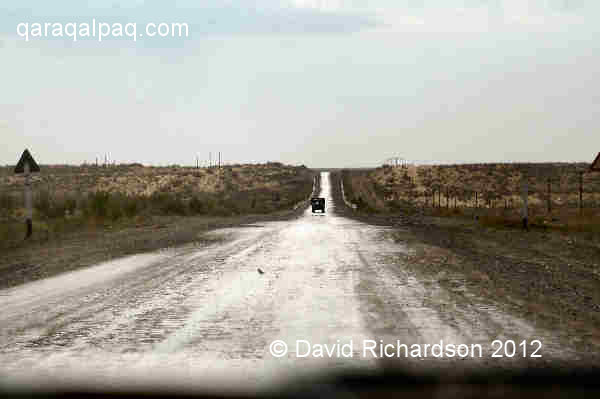
|
A recent loan from the Asian Development Bank means that sections of this route will be further upgraded between 2008 and 2011.
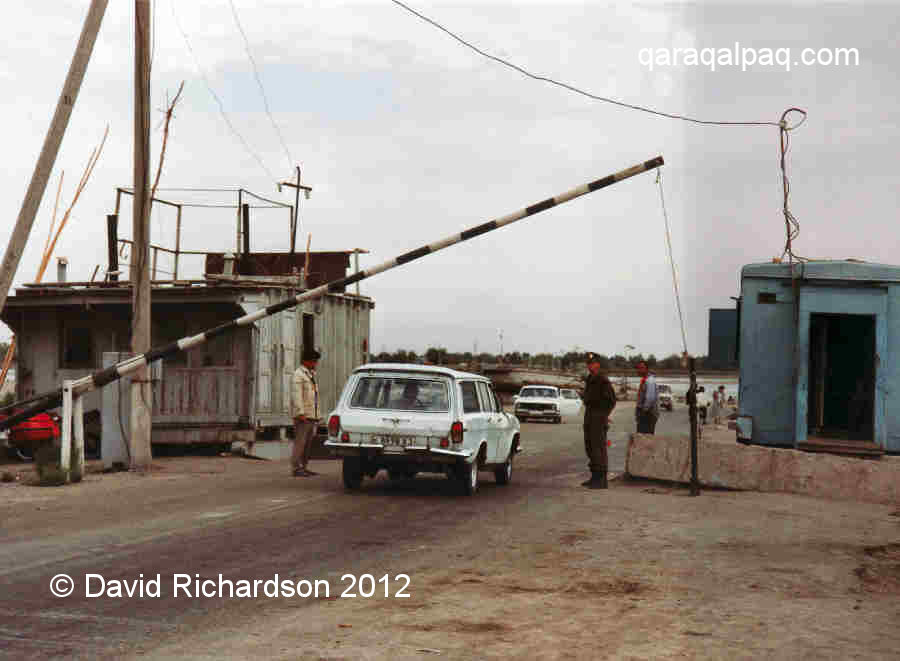
|
The main irritation of travelling by road is the frequency of road police checkpoints. Each viloyat has its own border checkpoint, so you
are checked out of one province and checked into the next. Someone once counted that there are fourteen checkpoints between Tashkent and No'kis.
All cars must stop but cars containing Western foreigners are generally waved through. If the police do request you to stop, they are mainly
interested in your driver's documentation. Only occasionally have we been asked to show our passports or to open our luggage.
Overland from Turkmenistan
Many visitors to Qaraqalpaqstan will want to visit the important nearby ruins of Gurganj (just outside of Konya Urgench), which are only 30km from
Xojeli. Some will want to get to Dashoguz to get a local flight to Ashgabat. More adventurous travellers will have made the interesting journey
across the Qara Qum from Ashgabat, staying overnight at the truck-stop close to the old Darvaza sulphur mine.
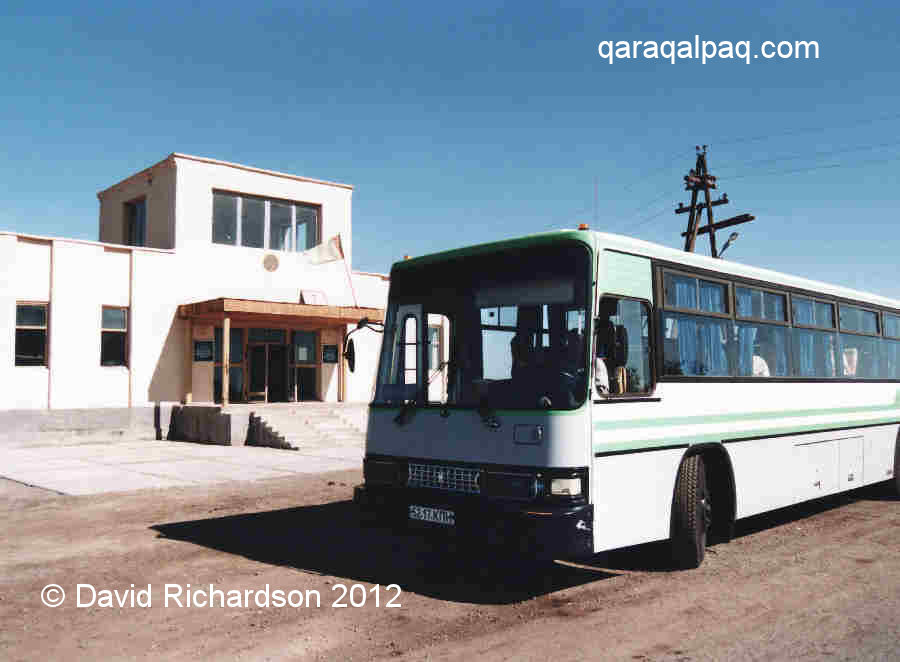
|
Some years ago it was possible to take a vehicle across the border into or out of Turkmenistan at the Xojeli/Mizdahkan-Konya Urgench border post.
However more restrictive regulations regarding the importation and exportation of vehicles and fuel (mainly imposed by Turkmenistan) make this an
impractical option today.
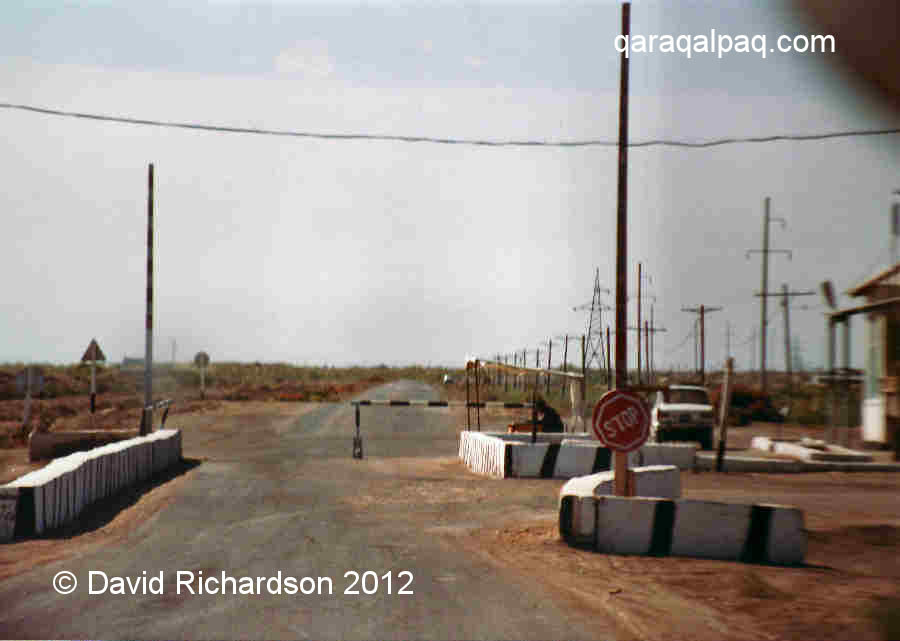
|
Today it is advisable to arrange for a vehicle to rendezvous with you on the other side of the border. For example, if departing from Turkmenistan,
you first say goodbye to your Turkmen driver and carry your luggage to the Turkmen border post to clear emigration and customs. This can take some
time, even when there is little cross-border activity - on one occasion we spent four hours waiting to be cleared. However couples travelling alone
normally get through within the hour. Normally all bags are hand-searched. You then walk half a kilometre through no-man's land to the Uzbek border
to have your visa checked and to complete your duplicate customs declaration. In the past bags were not hand searched on entry. However the Uzbek
authorities are continually upgrading their border controls. Once your documentaion is checked you are free to enter Qaraqalpaqstan and liaise with
your local driver who will hopefully be waiting for you.
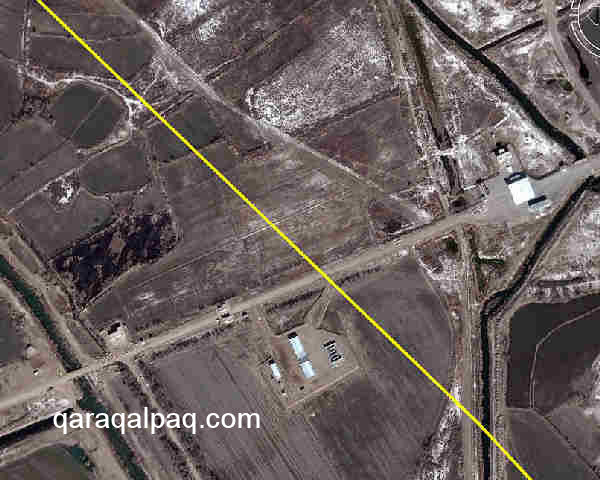
|
If you are staying at the Jipek Joli Hotel in No'kis they will arrange a car to collect you from the border for $25 - see
Accommodation in Qaraqalpaqstan. There are no bus services operating on either side of the border crossing.
The Uzbek checkpoint is 12km from Xojeli.
Overland from Kazakhstan
It is also possible to enter Qaraqalpaqstan from western Kazakhstan. Starting from Astrakhan, Uralsk, or Aqtubinsk, you must first drive to Makat.
From there a rough road runs across the Ustyurt plateau to Beyneu before crossing the Qaraqalpaqstan border at Oazis and continuing on to
Kungrad (Qon'ırat in Qaraqalpaq). The road - if it can be called such - is unmetalled for most of the Qazaq section, consisting of wide
corridor of parallel tracks. It can get quite muddy in places, especially between Beyneu and the Qaraqalpaqstan border. In Qaraqalpaqstan the road
generally follows the railway line. It is unmetalled from the border to Jaslıq, but is metalled from Jaslıq to Qon'ırat. People who have used
this road tell us that it is navigable without the need for a 4WD vehicle.
In recent years this route – known as the RD5 corridor - has become increasingly popular as a link between Russia and Qaraqalpaqstan, used by large
trucks and buses and for the importation of Russian-made cars. The United Nations has been promoting the idea of a Pan-Asian Highway across Central
Asia and now the Uzbek government are planning to upgrade and extend the existing A380. Part of the justification is to improve communications to
Qon'ırat, Qaraqalpaqstan's second major economic centre after No'kis. The aim is to create a long-distance route between Guzar in southern Uzbekistan
and the border crossing at Oazis (close to Beyneu in Kazakhstan) via Bukhara and No'kis. However the short-term priority is to improve the quality
of the A380 on some of its busiest sections, so it may take some time before the route across the Ustyurt gets upgraded.
It is vital that travellers using this crossing point obtain official entry clearance, having their passports stamped before they leave Kazakhstan
and after they enter Qaraqalpaqstan.
 |
This site was first published on 1 April 2008. It was last updated on 2 March 2012. © David and Sue Richardson 2005 - 2018. Unless stated otherwise, all of the material on this website is the copyright of David and Sue Richardson. |